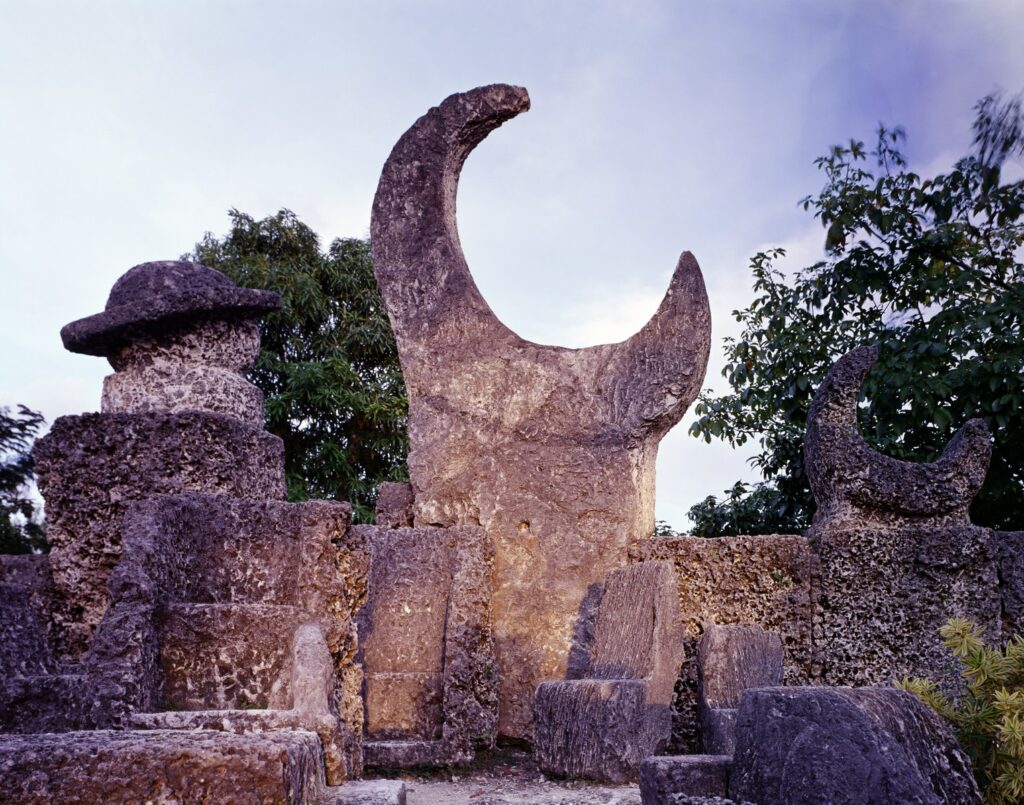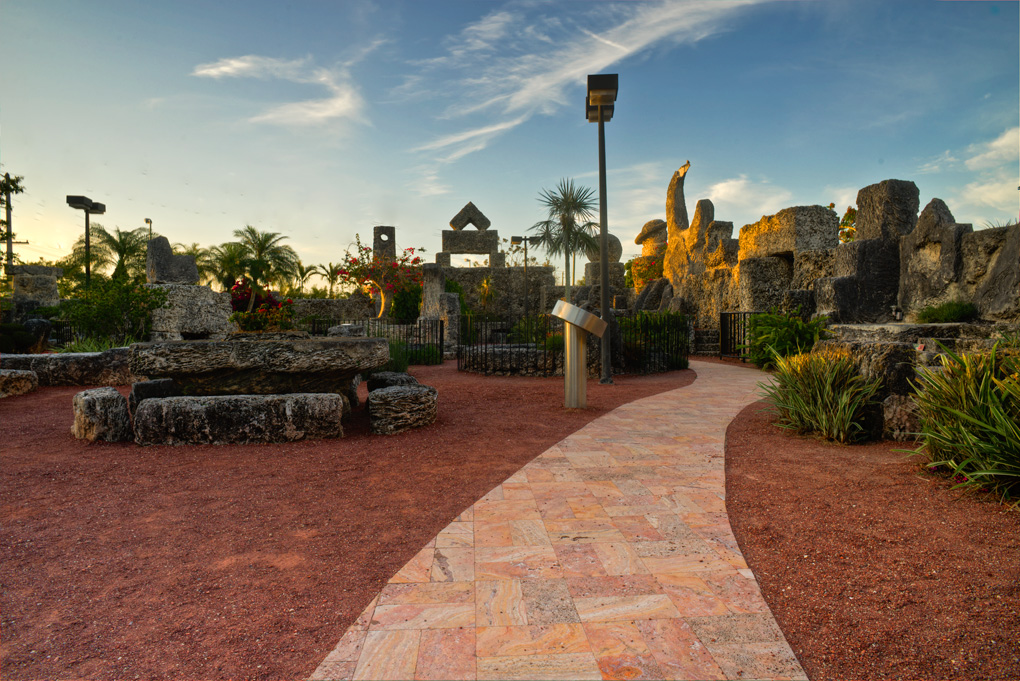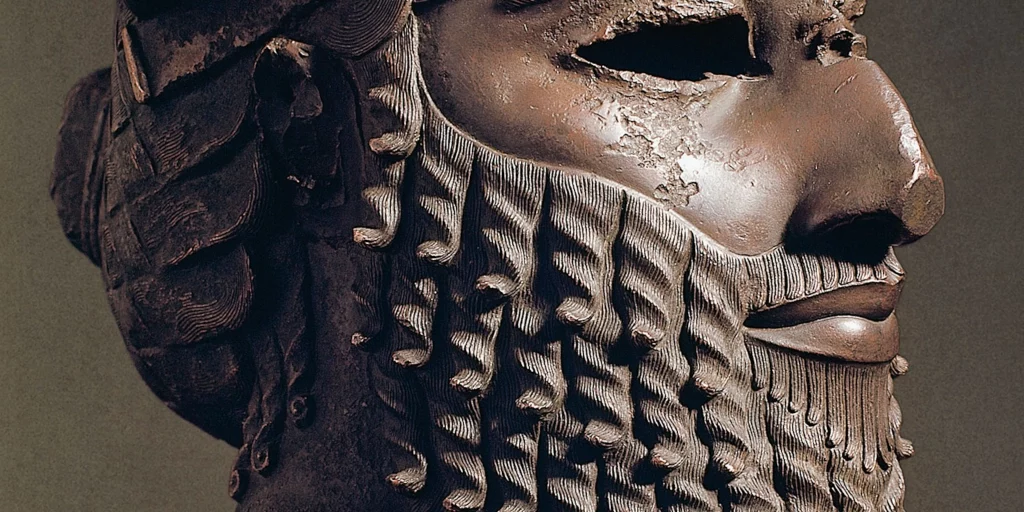On the outskirts of Miami-Dade County, Florida, between the cities of Homestead and Leisure City, stands a network of architecture constructed from thousands of stones weighing several tons each. They are sculpted into a variety of shapes including slab walls, tables and chairs, a giant crescent moon, a water fountain, and a sundial.
It is often referred to as Florida’s Stonehenge. The so-called “Coral Castle” was the labor of love by one man, Edward Leedskalnin. It is long believed that he had mystical knowledge of how to use “reverse magnetism” to carve, move, and align the gigantic stones.
Though not a castle in shape, nor actually made of coral (but rather limestone), it is by every measure of accomplishment a magnificent testament to Leedskalnin’s ingenuity and creativity. And, if the story is true, his lost love, Agnes.
Modern engineers believe they’ve solved the mystery of how Leedskalnin accomplished this extraordinary feat. But the result is no less mystifying to the hundreds of tourists and spectators who visit “Coral Castle” each year.
Now deemed a US National Park, “Coral Castle” is even listed on the National Register of Historic Places.

A Love Story Like No Other
Edward Leedskalnin was born on January 12, 1887, in Stāmeriena Parish, Latvia. He was the fifth son of Andrejs and Mina Leedskalnin, a family of sharecroppers who farmed rented land.
It is generally believed that Andrejs was by trade a stonemason who through the years passed his craft of cutting and setting stone on to his son. By one account, Leedskalnin himself practiced stonework for a few years as a young man.
According to “Coral Castle” legend, at 26 years of age, Leedskalnin proposed marriage to 16-year-old Agnes Skuvst. But just one day before they were to be wed, Skuvst called off their engagement.
She informed Leedskalnin that he was too old and too poor for her to marry. Leedskalnin was devastated and dejected.
Leedskalnin felt spurned by his one true love, the woman he would forever refer to as “Sweet Sixteen”. He then set out to prove to her and the world that despite his poverty, 4th-grade education, and diminutive size (barely 5′ tall, 100 pounds), he could accomplish something remarkable.
In 1912 he traveled to America to seek his fortune and prove his worthiness.
Finding His Way to Florida
Leedskalnin arrived in New York City in 1912. He looked for suitable work in stonemasonry on the US East Coast. Finding none, he relocated to the Pacific Northwest where he worked in the logging industry. (The 1920 census places his residence in Reedsport, Oregon.)
In the winter of 1922–1923, Leedskalnin contracted tuberculosis. This was a disease that at that time was usually fatal.
He later claimed to have cured himself using his knowledge of magnets. He made a near-full recovery, then headed to Florida to further improve his health. (This appears to be the first time Leedskalnin alluded to possessing knowledge of advanced physics.)
By early 1923, Leedskalnin found his way to the eastern side of Florida and purchased an undeveloped parcel of land in Florida City described as “lightly inhabited.” The Homestead Enterprise newspaper listed Leedskalnin’s purchase of the 1-acre lot and his intention to “erect a home soon.”
Birth of the Legend: The “Castle”
Over the next 10 years, Leedskalnin not only built a home but also constructed a series of stone structures he called “Rock Gate.” He dedicated this complex to “the girl who had left me years before.”
He worked alone and covertly (and mostly at night). Leedskalnin eventually quarried and hand-sculpted more than 1100 tons of oolite limestone into an architectural and engineering marvel. Those who first saw it referred to it as the “Coral Castle.”
He had only the most basic of tools at his disposal (mallet, saws, picks, winches, block & tackle). He scavenged timber and old automobile parts to expand his spectacular vision.
Leedskalnin attempted to keep his work private (his property was located in a remote area). But the construction of his unusual home drew the attention of curious neighbors and passers-by who were so awed by what they saw.
They would frequently stop and beg Leedskalnin to reveal how he moved the massive stones by himself. Leedskalnin would always reply, “I understand the laws of weight and leverage and I know the secrets of the people who built the pyramids.”
He saw how people marveled at his creation. So, in the early 1930s, Leedskalnin decided to open the “Coral Castle” to the public, offering tours for $.10. He even allowed grade-school teachers to bring their classes on field trips to visit, during which Leedskalnin would personally explain the methods he used.
This no doubt added a great amount of mystery. He liked to tell kids that the only advanced tool he used was a “perpetual motion holder.”
Paradise Nearly Lost
In the mid-1930s, after hearing talk of developing the land surrounding his property, Leedskalnin decided to sell his property and move to nearby Homestead, Florida.
But rather than abandon his extensive stone creation, he did what many people thought impossible—if not insane. He dismantled it and took it with him.
He bought a truck to accommodate the move. The “Castle” and all the surrounding features were disassembled and moved, block by block, ten miles to its present location. This was a 10-acre site near Homestead. The move took three years to complete. But he didn’t stop there.
Setting out to make his new site far more elaborate than the first, Leedskalnin continued to add new features to the structure. He was fortunate that his new property provided a massive supply of stone just a few yards beyond the “castle” walls.
He incorporated the resulting quarry, which was created by the removal of limestone into his creation. And he designed a beautiful Greek-style pool by the southern wall.
Leedskalnin named his new place “Rock Gate.” This was in reference to a new feature he engineered; a huge swinging stone gate he built into the back wall. It opened and closed as if it weighed next to nothing.
The Method of His Madness
Many aspects of Leedskalnin’s methodology remain pure speculation. But what is known is that the approach he used to fit the pieces of limestone together is ancient; reminiscent of Stonehenge.
Each stone sets atop others, kept in place by weight alone. They are fitted together so precisely that no mortar is needed. The craftsmanship Leedskalnin used in shaping each stone is so skillful that no light passes through the joints.
With few exceptions, the various features throughout the “Coral Castle” site are made from single slabs of stone weighing on average 14 to 15 tons each. The largest weighs 27 tons. The tallest, two monoliths, each stand at 25′.
The 8′ tall vertical stones that make up the perimeter wall are perfectly uniform in height. They are so well positioned that even after decades, they haven’t shifted in the slightest.
Features
The various structures and features constituting the “Coral Castle” are many and diverse. There are 8′ stone walls and various types of furniture. This includes a heart-shaped table, a “Florida” state-shaped table, 25 rocking chairs, chairs resembling crescent moons, and beds with intricate carvings.
It also includes a well and functioning fountain, a stone throne, an accurate sundial, a 30′-tall polar-aligned telescope, an obelisk, and the feature that inspired its enduring name, the “castle” tower.
But the feature that provides visitors the greatest sense of mystery is the revolving stone gate that, despite its massive size, can be moved with just the push of a finger.
The Magical Evolving Stone Door
Leedskalnin installed an 8-ton, 8′-tall revolving gate at the second site. It was carved so precisely that there is only a quarter-inch clearance from the framing walls. It is so perfectly balanced that even a child could open it using just one finger. It was even featured on both In Search of… and That’s Incredible! television shows.
Only after Leedskalnin’s death was the mystery of the gate solved; sort of.
In 1986, five years after Leedskalnin’s death, the mystery of the gate’s perfectly balanced axis and ease with which it revolved required examination when after decades it stopped working. Only then was the true genius and ingenuity of this feature (and the man who designed it) fully appreciated.
To remove the massive gate, six men and a 45-ton crane were required. While Leedskalnin alone had erected and installed it.
Once removed, engineers discovered that Leedskalnin had used a metal shaft and an old truck bearing to create the illusion. But they couldn’t explain how he had centered and balanced it so precisely.
Ironically, even with a modern, more technical understanding of how the gate functioned, engineers have been unable to make it rotate with the same ease it once did.

Leedskalnin’s Theories on Matter and Magnetism
Leedskalnin often claimed magnetism was essential to his stone construction So, to demonstrate his advanced understanding of it, he published four scholarly pamphlets in 1945.
These addressed the interaction between electricity, magnetism, and the body. They even included several simple experiments to validate his theories.
His thesis contradicted the commonly-accepted model of electromagnetism. It is based on the concept that where magnets are concerned, the metal itself is not the magnet. The actual magnets are circulating within the metal.
He claimed that individual magnets are particles smaller than atoms or photons. And that each particle in any substance is an individual magnet unto itself.
Furthermore, magnets are basically indestructible. While you can burn wood or flesh, and you can destroy the body, you cannot destroy the magnets that hold together the body.
Leedskalnin furthermore claimed that all matter is being acted upon by these individual magnets. He wrote that scientists (of his time) were looking in the wrong place for their understanding of electricity. And that they were observing only “half of the whole concept” with “one-sided tools of measurement.”
Distinguishing between the magnetic makeup of various substances he wrote, “Iron has more magnets than wood, and every substance has a different number of magnets holding that substance together.”
He said, “If I make a battery with copper for a positive terminal and beef for the negative terminal, I get more magnets out of it than when I use copper for the positive terminal and sweet potato for the negative. From this, you can see that no two things are alike.”
The Project Comes to an End
In November of 1951, after working virtually non-stop on his stone masterpiece for nearly 30 years, Edward Leedskalnin became too ill to proceed. He hung a sign on the front gate saying, “Going to the Hospital.”
He then boarded a bus to Jackson Memorial Hospital in Miami. Either en route to the hospital or during his hospital stay, Leedskalnin suffered a stroke. He subsequently died 28 days later of pyelonephritis (kidney infection) at the age of 64.
During the final years of his life, Leedskalnin made a fair income from conducting tours ($.25 at the latter site). He also sold pamphlets on various subjects (including magnetic currents). He also sold a portion of his 10-acre property for the construction of US Route 1 (which connects to the Florida Keys).
When the property was assessed after his death, authorities found $3500 among his personal belongings.
Since he left no will, the “Coral Castle” became the property of his closest living relative, a nephew named Henry, from Michigan. When Henry became ill in 1953, he sold the property to an Illinois family for an undisclosed amount of money.
It should be noted that a retired Chicago jeweler named Julius Levin claimed ownership of the property, upon his death.
The Coral Castle Museum
When visitors arrived at the “Coral Castle” in the 1940’s, they were greeted by Leedskalnin himself. He would promptly collect the $.25 admission fee, then take them and their imaginations on a journey the likes of which few had ever experienced.
As he led them around the premises, he would elaborate on the significance of each piece. The great pride he took in his work was apparent.
With the exception of a man named Orval Irwin, a long-time friend who frequently visited Leedskalnin at the “Coral Castle,” no one ever directly witnessed Leedskalnin’s building process and progress. Though many claimed to have glimpsed his work from afar.
As a result, this led to many outsiders becoming convinced that he possessed supernatural powers. Though he always denied it. He would, however, readily admit that he knew the secrets the ancient Egyptians used to build the pyramids. He would say that if he could learn them, others could, too.
Today, “Coral Castle” tours utilize pre-recorded “audio stands,” with narration available in English, Spanish, French, and German. If visitors prefer a more personalized tour of the grounds, knowledgeable guides are also available.
The tools Leedskalnin used to quarry rock are on display at the museum. It is accompanied by several old photographs showing the large tripods, pulleys, and winches he used to move and set the blocks.
The “Coral Castle” Memorialized
Leedskalnin’s incredible creations have been featured and discussed countless times in books, magazines, television shows, film, and other media, including:
Books
In 1996, Leedskalnin’s closest friend, Orval Irwin, published the book, Mr. Can’t Is Dead! The Story of the Coral Castle. In it, he demonstrates through photographs, drawings, and schematic diagrams how Leedskalnin accomplished his extraordinary feats of manipulating huge blocks of stone.
Irwin writes, “his was a generation who knew accomplishments by the sweat of the brow. It wasn’t mysticism but hard work, this is how Ed really accomplished the massive project.”
In the 2006 novel, The Island of Eternal Love, written by Daína Chaviano, the author dedicates the chapter “Very close to my heart” to the “Coral Castle” and Edward Leedskalnin.
John Martin’s 2012 book, Coral Castle Construction, describes how Leedskalnin likely built his structures, based on fundamental engineering principles.
Film
The 1958 film, The Wild Women of Wongo used the “Coral Castle” as the set for the “dragon-god” temple.
The lunar scenes in the 1961 film, Nude on the Moon, were shot at the “Coral Castle” site.
In the 1966 children’s musical film, Jimmy, the Boy Wonder, the “Coral Castle” was used as a backdrop for several memorable scenes.
TV
In 1981, Leonard Nimoy’s popular program, In Search of… aired “The Castle of Secrets.” The episode dramatized how Leedskalnin may have moved the massive stones.
In 2014, the History Channel spotlighted the “Coral Castle” in their Ancient Aliens series, “Mysterious Structures.”
Music
According to Rock star Billy Idol, his 1986 song “Sweet Sixteen” was inspired by the story of Leedskalnin and the 16-year-old bride who abandoned him.
Games
In the video game Fortnite, there is a location named “Coral Castle.”
References
coralcastle.com., “Coral Castle Museum,” Coral Castle Museum
livescience.com., “Mystery of the Coral Castle Explained,” Mystery of the Coral Castle Explained | Live Science
Allthatsinteresting.com., “The Enigma of Coral Castle, The 2.2-Million-Pound Monument Made By a Single Man,” https://allthatsinteresting.com/coral-castle
Youtube.com., “In Search of . . . Ed Leedskalnin’s Coral Castle Pt. 1,” https://www.youtube.com/watch?v=Kj5w_OiUUFU
Youtube.com., “The Castle of Secrets,” https://www.youtube.com/watch?v=T2m3C0hnzcU
Factsc.com., “Edward Leedskalnin, The Sculptor Who Single-Handedly Built Coral Castle,” https://factsc.com/edward-leedskalnin/
academia.edu., “Magnetic Current,” (PDF) Magnetic Current | Christopher A . Tucker – Academia.edu

